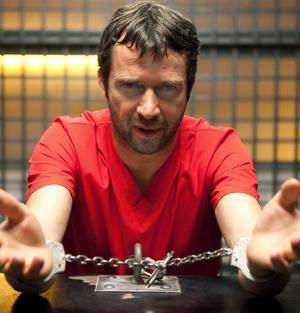‘Following’ chronicles ruthless murder in midst of humanity
January 24, 2013
In “The Following,” a new show created by Kevin Williamson, a convicted serial killer has escaped prison and slaughtered five guards in his wake. The killer, Joe Carroll (James Purefoy), is a tall, handsome European man with a menacing smirk and frightening eyes who believes in the beauty of death and the insanity of art.
“To bereave beauty is to elevate one’s soul; nothing is more beautiful than the death of a beautiful woman,” Carroll tells one of his victims (Natalie Zea), who happens to be the only survivor of the 15 women he assaulted and the incomplete brushstroke of his masterpiece — a work that literally demanded he feel his art, breathe every gory detail and find strength in the final weakness of others.
These words are spoken in a classroom in 2003. But most of the show is about the ugliness of death — its finality, its unscrupulousness and its effect on the living.
“The Following” chronicles this ugliness and the frustration of those who are unable to conquer it or to defeat those working as Death’s proxy. The virtue of “The Following,” however, is that each pang of excitement and horror there pays tribute to the reality of life and the delicacy of people; it combines ruthlessness and humanity and is largely dedicated to confusing the line between good and evil by making those who represent their polarity maddeningly complex.
The protagonist of Williamson’s story, former FBI agent Ryan Hardy (Kevin Bacon), harbors much of this depth, hidden beneath the guise of almost-laughable crime-drama cliches. Carroll’s escape is a primal moment for Hardy: It marks the rebirth of his career because according to an ominous phone call from the bureau, only Hardy can catch Carroll — a killer obsessed with the art of his hero, the gothic romantic author Edgar Allen Poe.
The flustered and upset look that plagues Hardy’s face when he finds out that the FBI needs his expertise makes it clear that Hardy is wounded by this serial killer and that revenge and redemption will be at the forefront of his chase.
This wound is both metaphoric and literal: Hardy was stabbed in the heart and now relies upon the steady beat of a pacemaker. And the same knife that wounded him also wounded the only surviving victim, symbolizing the strength of their connection. It’s as though her death would somehow cause his because she was the only girl he could save and the metaphorical trophy he flashed to prove it. She is his pacemaker and his crutch.
This woman, the only proof of Hardy’s virtue, is lost in the chaos of a murderer and his followers and is found dead with her eyes ripped out. Hardy is thrown back into the world of his own defeat, lost love and imperfection. He is forced to question what separates him from Carroll’s followers, what separates him from Carroll and why he fell in love with the ex-wife (Annie Parisse) of the man he convicted of murder. Carroll cannot feel or love as Poe could, yet he hides behind the mask of Poe in order to make his evil and gruesome actions noble and poetic.
That’s where the show finds its genius. It finds the flaws in a murderer but understands him, indicts him as knowing in his own crime. The complexity in the war between good and evil, or between Hardy and Carroll, lies in their similarities.







